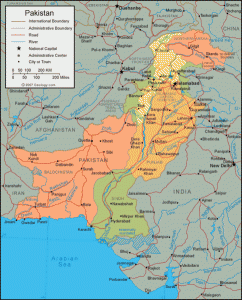Is Sharif Making a Play for Counterterrorism Funds US Cut from Afghanistan Budget?
Back in early November, the US carried out one of its most controversial drone strikes in Pakistan, killing TTP head Hakimullah Mehsud just hours before peace talks between the TTP and Pakistan were to begin. This move by the US seems to have pushed the TTP in a more radicalized direction, resulting in many new attacks. Pakistan’s government has responded to these attacks with counterattacks, effectively putting an end to prospects for restarting the talks.
Today, we see Sharif’s government vowing to take on another radical Sunni group, this time in Balochistan:
The government has finally decided to launch an operation against the feared Sunni terrorist outfit, the Lashkar-e-Jhangvi, and other militant groups involved in fomenting unrest in Balochistan.
The decision was taken in a meeting attended by Interior Minister Chaudhry Nisar, Balochistan Chief Minister Dr Abdul Malik Baloch, the Quetta corps commander, the Balochistan inspector general (IG) police and the Frontier Corps IG.
Dr Baloch was made in-charge of the operation against Lashkar-e-Jhangvi.
It is important to mention that the decision to launch an operation against terrorists was taken following an attack on Shias in Mastung that killed 29 pilgrims on Tuesday.
Significant government resources were brought in quickly after the attack on the bus:
The Government of Balochistan has suspended buses carrying pilgrims from travelling through the province to neighbouring Iran due to security concerns after a suicide attack killed 28 pilgrims in Mastung this week.
A 700 km highway connecting Quetta and Iran, home to many Shia pilgrimage sites, has seen dozens of suicide and roadside bomb attacks.
“We have temporarily suspended the movement of buses on the highway until the security situation improves,” a senior official of the Balochistan government told Reuters on Friday.
The provincial government then arranged C-130 flights to ferry 301 Shia pilgrims from Dalbandin town in Chagai district to Quetta International Airport for fear of more attacks on the pilgrims on Taftan-Quetta Highway. The pilgrims had entered Pakistan via Iran border in Taftan Town on Wednesday.
“The pilgrims were stopped in Taftan and barred from travelling by passenger buses. They were later shifted to Dalbandin under tight security,” another official said.
FC and Levies personnel escorted the pilgrims from Taftan to Dalbandin.
Although the C-130 flights were provided by the provincial government, the Frontier Corps is under the control of Pakistan’s army and so there appears to be national coordination in this response, as is also indicated by Nisar being mentioned in the Pakistan Today article quoted above (Prime Minister Nawaz Sharif, although not mentioned in the article, is in the accompanying photo).
Almost under the radar, we get word that talks begin in Washington, DC tomorrow on the “strategic” relationship between Pakistan and the US. It appears that counterterrorism is high on the list of topics under discussion: Read more →

